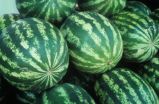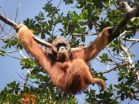(Press-News.org) Astronomers using the NASA/ESA Hubble Space Telescope have studied a giant filament of dark matter in 3D for the first time. Extending 60 million light-years from one of the most massive galaxy clusters known, the filament is part of the cosmic web that constitutes the large-scale structure of the Universe, and is a leftover of the very first moments after the Big Bang. If the high mass measured for the filament is representative of the rest of the Universe, then these structures may contain more than half of all the mass in the Universe.
The theory of the Big Bang predicts that variations in the density of matter in the very first moments of the Universe led the bulk of the matter in the cosmos to condense into a web of tangled filaments. This view is supported by computer simulations of cosmic evolution, which suggest that the Universe is structured like a web, with long filaments that connect to each other at the locations of massive galaxy clusters. However, these filaments, although vast, are made mainly of dark matter, which is incredibly difficult to observe.
The first convincing identification of a section of one of these filaments was made earlier this year [1]. Now a team of astronomers has gone further by probing a filament's structure in three dimensions. Seeing a filament in 3D eliminates many of the pitfalls that come from studying the flat image of such a structure.
"Filaments of the cosmic web are hugely extended and very diffuse, which makes them extremely difficult to detect, let alone study in 3D," says Mathilde Jauzac (LAM, France and University of KwaZulu-Natal, South Africa), lead author of the study.
The team combined high resolution images of the region around the massive galaxy cluster MACS J0717.5+3745 (or MACS J0717 for short), taken using Hubble, NAOJ's Subaru Telescope and the Canada-France-Hawaii Telescope, with spectroscopic data on the galaxies within it from the WM Keck Observatory and the Gemini Observatory. Analysing these observations together gives a complete view of the shape of the filament as it extends out from the galaxy cluster almost along our line of sight.
The team's recipe for studying the vast but diffuse filament combines several crucial ingredients.
First ingredient: A promising target. Theories of cosmic evolution suggest that galaxy clusters form where filaments of the cosmic web meet, with the filaments slowly funnelling matter into the clusters. "From our earlier work on MACS J0717, we knew that this cluster is actively growing, and thus a prime target for a detailed study of the cosmic web," explains co-author Harald Ebeling (University of Hawaii at Manoa, USA), who led the team that discovered MACS J0717 almost a decade ago.
Second ingredient: Advanced gravitational lensing techniques. Albert Einstein's famous theory of general relativity says that the path of light is bent when it passes through or near objects with a large mass. Filaments of the cosmic web are largely made up of dark matter [2] which cannot be seen directly, but their mass is enough to bend the light and distort the images of galaxies in the background, in a process called gravitational lensing. The team has developed new tools to convert the image distortions into a mass map.
Third ingredient: High resolution images. Gravitational lensing is a subtle phenomenon, and studying it needs detailed images. Hubble observations let the team study the precise deformation in the shapes of numerous lensed galaxies. This in turn reveals where the hidden dark matter filament is located. "The challenge," explains co-author Jean-Paul Kneib (LAM, France), "was to find a model of the cluster's shape which fitted all the lensing features that we observed."
Finally: Measurements of distances and motions. Hubble's observations of the cluster give the best two-dimensional map yet of a filament, but to see its shape in 3D required additional observations. Colour images [3], as well as galaxy velocities measured with spectrometers [4], using data from the Subaru, CFHT, WM Keck, and Gemini North telescopes (all on Mauna Kea, Hawaii), allowed the team to locate thousands of galaxies within the filament and to detect the motions of many of them.
A model that combined positional and velocity information for all these galaxies was constructed and this then revealed the 3D shape and orientation of the filamentary structure. As a result, the team was able to measure the true properties of this elusive filamentary structure without the uncertainties and biases that come from projecting the structure onto two dimensions, as is common in such analyses.
The results obtained push the limits of predictions made by theoretical work and numerical simulations of the cosmic web. With a length of at least 60 million light-years, the MACS J0717 filament is extreme even on astronomical scales. And if its mass content as measured by the team can be taken to be representative of filaments near giant clusters, then these diffuse links between the nodes of the cosmic web may contain even more mass (in the form of dark matter) than theorists predicted. So much that more than half of all the mass in the Universe may be hidden in these structures.
The forthcoming NASA/ESA/CSA James Webb Space Telescope, scheduled for launch in 2018, will be a powerful tool for detecting filaments in the cosmic web, thanks to its greatly increased sensitivity.
###
Notes
The Hubble Space Telescope is a project of international cooperation between ESA and NASA.
The international team of astronomers in this study consists of Mathilde Jauzac (Laboratoire d'Astrophysique de Marseille, France, and University of KwaZulu-Natal, South Africa), Eric Jullo (Laboratoire d'Astrophysique de Marseille, France and Jet Propulsion Laboratory, USA), Jean-Paul Kneib (Laboratoire d'Astrophysique de Marseille), Harald Ebeling (University of Hawaii, USA), Alexie Leauthaud (University of Tokyo, Japan), Cheng-Jiun Ma (University of Hawaii), Marceau Limousin (Laboratoire d'Astrophysique de Marseille and University of Copenhagen, Denmark), Richard Massey (Durham University, UK) and Johan Richard (Lyon Observatory, France)
The research is presented in a paper entitled "A Weak-Lensing Mass Reconstruction of the Large-Scale Filament Feeding the Massive Galaxy Cluster MACSJ0717.5+3745", to be published in the 1 November 2012 issue of Monthly Notices of the Royal Astronomical Society. The paper will be published online this week.
[1] The first identification of a dark matter filament was published in J. Dietrich et al, "A filament of dark matter between two clusters of galaxies" published in Nature on 4 July 2012.
[2] Dark matter, which makes up around three quarters of all matter in the Universe, cannot be seen directly as it does not emit or reflect any light, and can pass through other matter without friction (it is collisionless). It interacts only by gravity, and its presence must be deduced from its gravitational effects, for example its effect on the rotation rate of galaxies and its ability to deflect light according to the theory of general relativity.
[3] The light captured by telescopes encapsulates information about the object that emitted it. One important application of this is to study the redshift of an object (the extent to which its light is reddened by the expansion of the Universe) which can be used to measure distances. Estimating distances based on the relative brightnesses of colours that galaxies appear in images is done using a technique called photometric redshift. Although the precision of the distance estimate is limited, it is a relatively straightforward technique to use on large numbers of galaxies, and it works well even for faint objects.
[4] Spectrometers analyse the detailed properties of the light coming from an object. In this study, the subset of galaxies observed with spectrometers provided detailed information on the motion of the objects within the filament.
Dark matter filament studied in 3-D for the first time
2012-10-16
ELSE PRESS RELEASES FROM THIS DATE:
The sound in Saturn's rings: RUB-Physicists explain nonlinear dust acoustic waves in dusty plasmas
2012-10-16
Dusty plasmas can be found in many places both in space and in the laboratory. Due to their special properties, dust acoustic waves can propagate inside these plasmas like sound waves in air, and can be studied with the naked eye or with standard video cameras. The RUB physicists Prof. Dr. Dr. h.c. Padma Kant Shukla and Dr. Bengt Eliasson from the Faculty of Physics and Astronomy have published a model with which they describe how large amplitude dust acoustic waves in dusty plasmas behave. The researchers report their new findings in the journal Physical Review E.
Different ...
Novel discovery links anti-cancer drugs to muscle repair
2012-10-16
OTTAWA, October 16, 2012 – Few drugs are available to treat muscle injury, muscle wasting and genetic disorders causing muscle degeneration, such as Duchenne muscular dystrophy. A compelling discovery that may change this was made recently by a research group led by Dr. Robert Korneluk, distinguished professor at University of Ottawa's Faculty of Medicine and founder of the CHEO Research Institute's Apoptosis Research Centre, was reported today in Science Signaling.
"We know of five pharmaceutical companies pursuing phase one clinical trials with specific drugs to treat ...
Pollenizer research should help seedless watermelon farmers
2012-10-16
Research from North Carolina State University on flower production and disease resistance in watermelon varieties should help bolster seedless watermelon harvests for farmers.
Seedless watermelons are more popular than seeded watermelons, making them a more profitable crop for farmers. But the flowers of seedless watermelon plants must be fertilized with pollen from the male flowers of seeded watermelon plants, because seedless plants do not produce genetically viable pollen.
This is a problem, because seeded watermelon plants take up space, nutrients and water that ...
A change of strategy is needed to save the Sumatran orangutans
2012-10-16
This press release is available in German.
Orangutans are the only large apes in Asia and mainly live in trees. Today, the population only includes two species: While the Borneo orangutan populates large sections of the Southeast Asian island of Borneo, nowadays the Sumatran orangutan is only found at the northern tip of the island of Sumatra. With a current population of only around 6,600 Sumatra orangutans, a figure which is dropping rapidly and constantly, this species is on the Red List of Threatened Species.
When large areas of rainforest were cleared in Sumatra ...
Less-invasive method of brain stimulation helps patients with Parkinson's disease
2012-10-16
Philadelphia, Pa. (October 16, 2012) – Electrical stimulation using extradural electrodes—placed underneath the skull but not implanted in the brain—is a safe approach with meaningful benefits for patients with Parkinson's disease, reports the October issue of Neurosurgery, official journal of the Congress of Neurological Surgeons. The journal is published by Lippincott Williams & Wilkins, a part ofWolters Kluwer Health.
The technique, called extradural motor cortex stimulation (EMCS), may provide a less-invasive alternative to electrical deep brain stimulation (DBS) ...
Stat5 predicts outcomes for prostate cancer patients after radical prostatectomy
2012-10-16
PHILADELPHIA—Men who had high levels of the activated Stat5 protein in their prostate cancer after a radical prostatectomy were more likely to have a recurrence or die from the disease compared to men who had little to no presence of the growth protein, according to a recent study published in Human Pathology by Jefferson's Kimmel Cancer Center researchers.
This suggests, Stat5, a protein that when activated signals cancer cells to grow and survive, could be an ideal biomarker to help guide patients and physicians for future treatment.
The research team, led by ...
Presidential candidate body language plays little role in voter perception
2012-10-16
Washington, DC (October 16, 2012) Viewer impressions of political candidates are heavily weighted to the content of their speech rather than the body language, a new study published in the Journal of Communication has found. The research, conducted by a trio of German scholars, presents a shift from past research showing that nonverbal communication plays a larger role than verbal in presidential debates.
Marcus Maurer (Friedrich-Schiller-Universitaet), Friederike Nagel (Johannes Gutenberg-Universitaet), and CarstenReinemann (Ludwig Maxillians-Universitaet) conducted ...
Eating lots of carbs, sugar may raise risk of cognitive impairment, Mayo Clinic study finds
2012-10-16
ROCHESTER, Minn. -- People 70 and older who eat food high in carbohydrates have nearly four times the risk of developing mild cognitive impairment, and the danger also rises with a diet heavy in sugar, Mayo Clinic researchers have found. Those who consume a lot of protein and fat relative to carbohydrates are less likely to become cognitively impaired, the study found. The findings are published in the Journal of Alzheimer's Disease.
The research highlights the importance of a well-rounded diet, says lead author Rosebud Roberts, M.B., Ch.B., a Mayo Clinic epidemiologist.
"We ...
Starvation hormone markedly extends mouse life span, UT Southwestern researchers report
2012-10-16
DALLAS – Oct. 15, 2012 – A study by UT Southwestern Medical Center researchers finds that a starvation hormone markedly extends life span in mice without the need for calorie restriction.
"Restricting food intake has been shown to extend lifespan in several different kinds of animals. In our study, we found transgenic mice that produced more of the hormone fibroblast growth factor-21 (FGF21) got the benefits of dieting without having to limit their food intake. Male mice that overproduced the hormone had about a 30 percent increase in average life span and female mice ...
Presidential debates say as much about US culture as candidates
2012-10-16
ANN ARBOR—American presidential campaigns provide a unique window into our society, according to a University of Michigan anthropologist.
"It says a lot about our culture that we pay so much attention to the clothing, gestures and hair styles of presidential candidates and to their performances in highly theatrical situations, like debates," said Michael Lempert, a linguistic anthropologist at the U-M.
Lempert is the co-author with University of Chicago anthropologist Michael Silverstein of "Creatures of Politics: Media, Message, and the American Presidency," just ...



